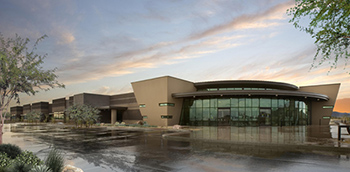Arizona Game and Fish Building Exemplifies Green Leadership
 PHOENIX — The Arizona Game and Fish headquarters in Phoenix isn’t the newest LEED Platinum-certified building in the region, but it’s been getting attention for its environmentally friendly assets since its construction in 2007.
PHOENIX — The Arizona Game and Fish headquarters in Phoenix isn’t the newest LEED Platinum-certified building in the region, but it’s been getting attention for its environmentally friendly assets since its construction in 2007.
After winning local and regional TOBY (The Outstanding Building of the Year) Awards from the Building Owners and Managers Association (BOMA), the building won an international 2013-2014 TOBY Award, which was announced June 24 at BOMA’s conference in Orlando.
The facility is one of Arizona’s first government buildings to achieve the prestigious LEED Platinum level. In fact, when it was built seven years ago, it became only the fourth building in the entire state to reach that level of sustainability. At the time, seeking a private-public partnership, the department opened itself up to a request for proposal (RFP) process to find a developer that would be able to build, operate and maintain the facility. Dallas, Texas-based Lincoln Property Company won the contract, and the commercial real estate developer would lease the building for the next 30 years, after which the state of Arizona will own it.
Two years before development began, the state of Arizona passed an executive order mandating all state-funded buildings meet at least the LEED Silver level. Being an icon of environmental sustainability, the game and fish department wanted to reach for platinum. It turned to Green Ideas in Phoenix, a consulting and educational services company in the field of green building. It’s also a forerunner in LEED continuing education.
“Obviously the game and fish department’s mission is to make sure we have a suitable habit for wildlife. It really fit well into their overall mission as a conservation group,” said Charlie Popeck, Green Ideas president. Popeck also founded Arizona’s U.S Green Building Council in 2003.
In addition to preservation of the land surrounding the building, the facility features a number of sustainable strategies including zero CFC-based refrigerants; a high-performance, reflecting roofing system; low-flow fixtures; occupancy sensors and a permanent monitoring system; architectural features that control solar heat gain; harvested wood products from Forest Stewardship-certified forests; and low VOC-emitting materials.
One of the most unique aspects of the project was the photovoltaic (PV) system, Popeck said. The 189-kilowatt rooftop PV system generates an estimated 290,000 kwh annually, which offsets the equivalent of 208 metric tons of CO2 emissions.
“On this project, Green Ideas was able to negotiate the first third-party power purchase agreement for a public building in the state of Arizona. That third party installs, owns and operates the system, and they harvest all rebates and tax credits, but the project gets credit for the renewable energy system on the roof,” Popeck said. “Although the initial target was silver, we had a very talented team who have done a lot of sustainable projects, and the owner was very motivated. They did the first thing that is very important if you want a very high-performance LEED platinum building — they started early.”
